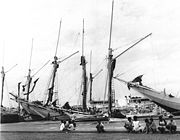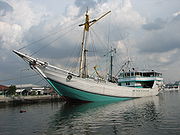
Pinisi
Encyclopedia


Indonesia
Indonesia , officially the Republic of Indonesia , is a country in Southeast Asia and Oceania. Indonesia is an archipelago comprising approximately 13,000 islands. It has 33 provinces with over 238 million people, and is the world's fourth most populous country. Indonesia is a republic, with an...
n two masted sailing ship
Sailing ship
The term sailing ship is now used to refer to any large wind-powered vessel. In technical terms, a ship was a sailing vessel with a specific rig of at least three masts, square rigged on all of them, making the sailing adjective redundant. In popular usage "ship" became associated with all large...
. It was mainly built by the Konjo tribe, a sub-ethnic group of Bugis-Makassar mostly residents at the Bulukumba regency of South Sulawesi
South Sulawesi
South Sulawesi is a province of Indonesia, located on the western southern peninsula of Sulawesi Island. The province is bordered by Central Sulawesi province to the north, South East Sulawesi province to the east and West Sulawesi province to the west...
but was and currently used widely by the Buginese
Bugis
The Bugis are the most numerous of the three major linguistic and ethnic groups of South Sulawesi, the southwestern province of Sulawesi, Indonesia's third largest island. Although many Bugis live in the large port cities of Makassar and Parepare, the majority are farmers who grow wet rice on the...
and Makassarese
Makassar
Makassar, is the provincial capital of South Sulawesi, Indonesia, and the largest city on Sulawesi Island. From 1971 to 1999, the city was named Ujung Pandang, after a precolonial fort in the city, and the two names are often used interchangeably...
mostly for transportation and agricultural purpose.
General description
The hull of the ships looks similar to that of a dhowDhow
Dhow is the generic name of a number of traditional sailing vessels with one or more masts with lateen sails used in the Red Sea and Indian Ocean region. Some historians believe the dhow was invented by Arabs but this is disputed by some others. Dhows typically weigh 300 to 500 tons, and have a...
while the fore-and-aft rig
Fore-and-aft rig
A fore-and-aft rig is a sailing rig consisting mainly of sails that are set along the line of the keel rather than perpendicular to it. Such sails are described as fore-and-aft rigged....
ging reminds of western schooner
Schooner
A schooner is a type of sailing vessel characterized by the use of fore-and-aft sails on two or more masts with the forward mast being no taller than the rear masts....
s, although it might be more correctly termed to resemble a ketch
Ketch
A ketch is a sailing craft with two masts: a main mast, and a shorter mizzen mast abaft of the main mast, but forward of the rudder post. Both masts are rigged mainly fore-and-aft. From one to three jibs may be carried forward of the main mast when going to windward...
, as the front mast is the larger.
The large mainsails differ from western style gaff rig
Gaff rig
Gaff rig is a sailing rig in which the sail is four-cornered, fore-and-aft rigged, controlled at its peak and, usually, its entire head by a spar called the gaff...
s though, as they often do not have a boom
Boom (sailing)
In sailing, a boom is a spar , along the foot of a fore and aft rigged sail, that greatly improves control of the angle and shape of the sail. The primary action of the boom is to keep the foot of the sail flatter when the sail angle is away from the centerline of the boat. The boom also serves...
and the sail is not lowered with the gaff
Gaff rig
Gaff rig is a sailing rig in which the sail is four-cornered, fore-and-aft rigged, controlled at its peak and, usually, its entire head by a spar called the gaff...
. Instead it is reefed towards the mast, much like a curtain, thus allowing the gaff to be used as deck crane
Crane (machine)
A crane is a type of machine, generally equipped with a hoist, wire ropes or chains, and sheaves, that can be used both to lift and lower materials and to move them horizontally. It uses one or more simple machines to create mechanical advantage and thus move loads beyond the normal capability of...
in the harbour. The lower part of the mast itself may resemble a tripod
Tripod
A tripod is a portable three-legged frame, used as a platform for supporting the weight and maintaining the stability of some other object. The word comes from the Greek tripous, meaning "three feet". A tripod provides stability against downward forces, horizontal forces and moments about the...
or is made of two poles.
Pinisi may be 20 to 35 meters long and 350 tons in size. The masts may reach to 30 meters above the deck.
Types of Pinisi
There are two general types of Pinisi.- Lamba or lamboLambo (boat)The lambo or lamba is a type of Pinisi, Indonesian traditional merchant boat, akin to a cutter.During the 1970s the Indonesian local vessels were progressively equipped with engines. Since machine installation did not fit well in traditional pinisi designs, lambos became a common alternative...
. Pinisi of a long and slender built, having a straight stern. This type of Pinisi is the one currently surviving in its motorized version (PLM). - Palari. Older type of Pinisi with a curved stern and keel. They were usually smaller than the Lamba.
History
The first pinisi ships are said to have been built after the example of the Dutch "Pinas" introduced to the region by the V.O.C.Dutch East India Company
The Dutch East India Company was a chartered company established in 1602, when the States-General of the Netherlands granted it a 21-year monopoly to carry out colonial activities in Asia...
around 1600.
These probably sported lateen
Lateen
A lateen or latin-rig is a triangular sail set on a long yard mounted at an angle on the mast, and running in a fore-and-aft direction....
or other type of sails, as the modern schooner rig did not become prominent before the 19th century.
Based on Buginese lontara
Lontara
Lontara or lontaraq are Bugis palm-leaf manuscripts that record knowledge on such topics as history, science, custom, and laws. The term originates from the Javanese/Malay word lontar, which is the type of tree that provides the leaves used....
and inherited story between Buginese, pinisi are used widely by Buginese for multiple purposes, such as transport ship, sailing boat, and battle ship.
During the alliance period with the Dutch colonialist, pinisi boat are mainly used as trade ships, transportation, and fishing. Some source mentioned that since the Indonesian National Awakening
Indonesian National Awakening
The Indonesian National Awakening is a term for the period in the first half of the twentieth century, during which people from many parts of the archipelago first began to develop a national consciousness as "Indonesians"....
pinisi are used by Buginese and people of Sulawesi as a battleship or backup line to help Indonesia gaining her independence.
Design & Construction
There are several anatomical part of pinisi that still mentioned in their original Buginese name, such as:1. Anjong, (balancing triangle) located at the front deck (Anjungan)
2. Sombala (main sail) the largest sail in the ship
3. Tanpasere (small sail) triangle-shaped, located at each mast
4. Cocoro pantara (front additional sail).
5. Cocoro tangnga (middle additional sail)
6. Tarengke (row additional sail))
7. etc.
Modern Use
As with many traditional ship types nowadays, pinisi have been provided with motors. This has somewhat changed the appearance of the ships, that until about 1970 had largely remained pure sailing ships. Comparable to modern dhows the masts have been shortened or when not needed as deck cranes vanished completely, while the structures on deck have been enlarged for the crew and passengers, usually restricted to the aft parts though.Further reading
- G. Adrian Horridge, The Konjo boatbuilders and the Bugis Prahus of south Sulawesi, National Maritime Museum, London 1979.

